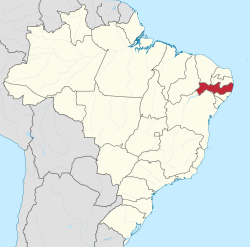
Back Pernambuco Afrikaans Pernambuco AN بيرنامبوكو Arabic Pernambuco AST Pernambuco Istadu Aymara Pernambuku Azerbaijani Пернамбуку Byelorussian Пэрнамбуку BE-X-OLD Пернамбуко Bulgarian পেরনামবুকো BPY
Pernambuco | |
|---|---|
|
| |
| Motto(s): | |
| Anthem: Hino de Pernambuco | |
 Location of State of Pernambuco in Brazil | |
| Coordinates: 8°20′S 37°48′W / 8.333°S 37.800°W | |
| Country | |
| Capital and largest city | Recife |
| Government | |
| • Governor | Raquel Lyra (PSDB) |
| • Vice Governor | Priscila Krause (Cidadania) |
| • Senators | |
| Area | |
• Total | 98,067.877 km2 (37,864.219 sq mi) |
| • Rank | 19th |
| Population (19/09/2024)[1] | |
• Total | 13,401,109 |
| • Rank | 7th |
| • Density | 140/km2 (350/sq mi) |
| • Rank | 6th |
| Demonym(s) | Pernambucan (English), Pernambucano or Pernambucana (Brazilian Portuguese) |
| GDP | |
| • Total | R$ 222.814 billion (US$ 41.961 billion) |
| HDI | |
| • Year | 2021 |
| • Category | 0.777[3] – high (15th) |
| Time zones | UTC−3 (BRT) |
| UTC−2 (FNT) | |
| Postal Code | 50000-000 to 56990-000 |
| ISO 3166 code | BR-PE |
| License Plate Letter Sequence | KFD to KME, NXU to NXW, OYL to OYZ, PCA to PGZ, QYA to QYZ, RZE to RZZ, SNK to SPB |
| Website | pe.gov.br |
Pernambuco (Brazilian Portuguese: [pɛʁnɐ̃ˈbuku] ) is a state of Brazil located in the Northeast region of the country. With an estimated population of 13 million people as of 2022, it is the seventh-most populous state of Brazil and with around 98,067.877 km2, it is the 19th-largest in area among federative units of the country. It is also the sixth-most densely populated with around 89 people per km2. Its capital and largest city, Recife, is one of the most important economic and urban hubs in the country. Based on 2019 estimates, the Recife Metropolitan Region is seventh-most populous in the country, and the second-largest in northeastern Brazil.[4] In 2015, the state had 4.4% of the national population and produced 2.8% of the national gross domestic product (GDP).[5]
The contemporary state inherits its name from the Captaincy of Pernambuco, established in 1534. The region was originally inhabited by Tupi–Guarani-speaking peoples. European colonization began in the 16th century, under mostly Portuguese rule interrupted by a brief period of Dutch rule, followed by Brazilian independence in 1822. Large numbers of slaves were brought from Africa during the colonial era to cultivate sugarcane, and a significant portion of the state's population has some amount of African ancestry.
The state has rich cultural traditions thanks to its varied history and peoples. Brazilian Carnivals in Recife and the historic colonial capital of Olinda are renowned: the Galo da Madrugada parade in Recife has held world records for its size.
Historically a center of sugarcane cultivation due to the favorable climate, the state has a modern economy dominated by the services sector today, though large amounts of sugarcane are still grown. The coming of democracy in 1985 has brought the state progress and challenges in turn: while economic and health indicators have improved, inequality remains high.
- ^ "2022 Census Overview" (in Portuguese).
- ^ "PIB por Unidade da Federação, 2021". ibge.gov.br.
- ^ "Atlas do Desenvolvimento Humano no Brasil. Pnud Brasil, Ipea e FJP, 2024". www.atlasbrasil.org.br. Retrieved 11 June 2023.
- ^ "Estimativas 2019 população Regiões Metropolitanas". agenciadenoticias.ibge.gov.br (in Brazilian Portuguese). Retrieved 10 April 2021.
- ^ Spilimbergo, Antonio; Srinivasan, Krishna (14 March 2019). Chapter 12 The Subnational Fiscal Crisis. International Monetary Fund. ISBN 978-1-4843-3974-9.

